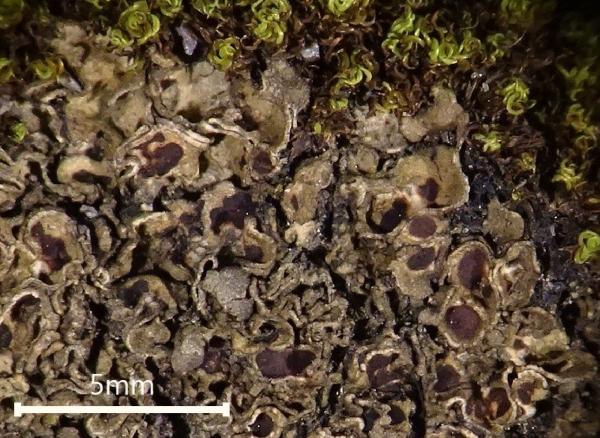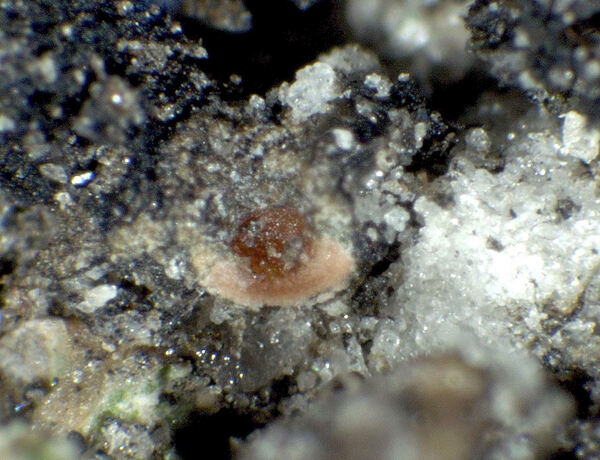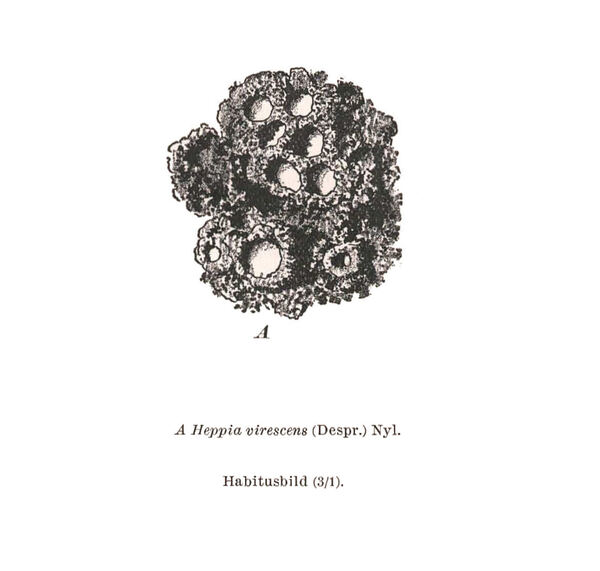Heppia adglutinata (Kremp.) A. Massal.
Geneac. Lich.: 8, 1854. Basionym: Lecanora adglutinata Kremp. - Flora, 24: 675, 1851.
Synonyms: Heppia monguillonii Harm.; Heppia urceolata Nägeli ex Hepp; Heppia virescens (Mont.) Nyl.; Nylanderopsis salevensis Gyeln.; Solorina virescens Mont.
Description: Thallus squamulose, heteromerous, rather thick, olive-yellowish to ochraceous brown both when dry and when moist, with pale punctiform depressions in a reticulate pattern. Squamules subpeltate, 1.5-2(-3) mm broad, at first flat, then concave, contiguous, with rounded ends and a down-turned edges, attached by a mat of 10-14 µm thick, colourless rhizohyphae. Upper cortex paraplectenchymatous, (12-)25-50(-70) µm thick, of periclinally arranged hyphae, covered with a 7-12 µm thick epinecral layer; medulla poorly developed; lower cortex absent or restricted to the margins. Apothecia without a thalline margin, semi-immersed in the squamules, up to 2 mm across, with a dark reddish brown, concave to flat disc, and a thin to indistinct proper margin. Proper exciple 20-50 µm wide laterally; epithecium brownish, K-; hymenium colourless, 120-180(-195) µm high, K/I+ reddish; paraphyses mostly simple, lax, distinctly thickened above; hypothecium colourless, 20-35 µm high. Asci 8-spored, with a very thin wall disintegrating or opening by apical ruptures, Lichina-type. Ascospores 1-celled (sometimes apparently 1-septate), hyaline, ellipsoid, thin-walled, 20-23 x 7-8 µm. Pycnidia dark, immersed. Conidia fusiform, 2.5-3.5 x 1-1.5 µm. Photobiont cyanobacterial, Scytonema-like. Spot tests: K-, C-, KC-, P-, UV-. Chemistry: without lichen substances.
Growth form: Squamulose
Substrata: soil, terricolous mosses, and plant debris
Photobiont: cyanobacteria, filamentous (e.g. Nostoc, Scytonema)
Reproductive strategy: mainly sexual
Pioneer species
Commonnes-rarity: (info)
Alpine belt: extremely rare
Subalpine belt: very rare
Montane belt: very rare
Dry submediterranean belt: absent
Humid submediterranean belt: absent
Padanian area: absent
pH of the substrata:
1 2 3 4 5
Solar irradiation:
1 2 3 4 5
Aridity:
1 2 3 4 5
Eutrophication:
1 2 3 4 5
Poleotolerance:
0 1 2 3
Altitudinal distribution:
1 2 3 4 5 6
Rarity
absent
extremely rare
very rare
rare
rather rare
rather common
common
very common
extremely common
Loading data...
Occurrence data
Predictive map

Source: Klepsland, J. T. 2020. Thirty lichens and lichenicolous fungi new to Norway. Graphis Scripta 32 (7): 120– 143. Oslo. ISSN 2002-4495. - CC BY-4.0
O L-227195

Collezione lichenologica Abramo Massalongo del Museo di Storia Naturale G. Ligabue di Venezia - Autori: Seggi, Linda; Trabucco, Raffaella Proprietà: Fondazione Musei Civici di Venezia - CC BY-NC
Italy, Veneto, In M. Alba ad terram 1855

Felix Schumm - CC BY-4.0
[VZR154], Insulae Canarienses, Tenerife. Las Montañas de Anaga,
Santa Cruz de Tenerife, Igueste, in valle Lomo de la Cruz, 300- 400 m.
Ad saxa eruptiva humida. Leg. A. Vezda. EX A. VEZDA: LICHENES
RARIORES EXSICCATI NR. 154.

Felix Schumm - CC BY-4.0
[VZR154], Insulae Canarienses, Tenerife. Las Montañas de Anaga,
Santa Cruz de Tenerife, Igueste, in valle Lomo de la Cruz, 300- 400 m.
Ad saxa eruptiva humida. Leg. A. Vezda. EX A. VEZDA: LICHENES
RARIORES EXSICCATI NR. 154.
Growth form: Squamulose
Substrata: soil, terricolous mosses, and plant debris
Photobiont: cyanobacteria, filamentous (e.g. Nostoc, Scytonema)
Reproductive strategy: mainly sexual
Pioneer species
Commonnes-rarity: (info)
Alpine belt: extremely rare
Subalpine belt: very rare
Montane belt: very rare
Dry submediterranean belt: absent
Humid submediterranean belt: absent
Padanian area: absent
pH of the substrata:
| 1 | 2 | 3 | 4 | 5 |
Solar irradiation:
| 1 | 2 | 3 | 4 | 5 |
Aridity:
| 1 | 2 | 3 | 4 | 5 |
Eutrophication:
| 1 | 2 | 3 | 4 | 5 |
Poleotolerance:
| 0 | 1 | 2 | 3 |
Altitudinal distribution:
| 1 | 2 | 3 | 4 | 5 | 6 |
Rarity
absent
extremely rare
very rare
rare
rather rare
rather common
common
very common
extremely common
Loading data...
Occurrence data
Predictive map

Source: Klepsland, J. T. 2020. Thirty lichens and lichenicolous fungi new to Norway. Graphis Scripta 32 (7): 120– 143. Oslo. ISSN 2002-4495. - CC BY-4.0
O L-227195

Collezione lichenologica Abramo Massalongo del Museo di Storia Naturale G. Ligabue di Venezia - Autori: Seggi, Linda; Trabucco, Raffaella Proprietà: Fondazione Musei Civici di Venezia - CC BY-NC
Italy, Veneto, In M. Alba ad terram 1855

Felix Schumm - CC BY-4.0
[VZR154], Insulae Canarienses, Tenerife. Las Montañas de Anaga, Santa Cruz de Tenerife, Igueste, in valle Lomo de la Cruz, 300- 400 m. Ad saxa eruptiva humida. Leg. A. Vezda. EX A. VEZDA: LICHENES RARIORES EXSICCATI NR. 154.












